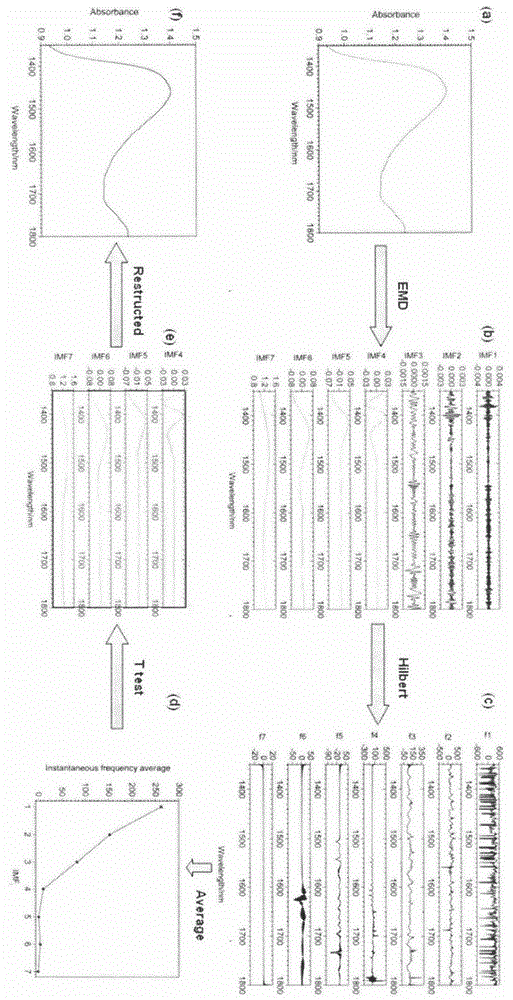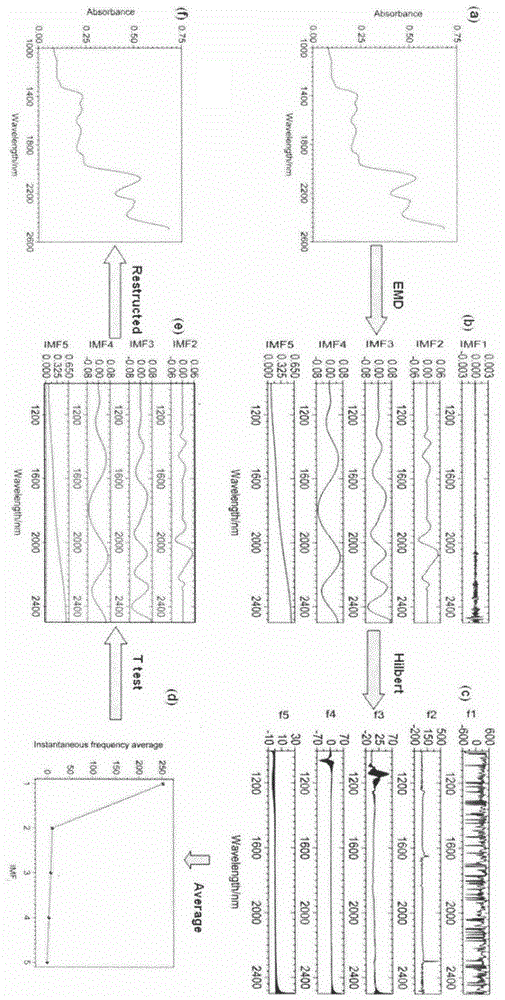Spectrum signal denoising method based on Hilbert-Huang transformation
A yellow transform and signal technology, which is applied in the direction of material analysis, measuring device, and instrument by optical means, can solve the problem of lack of adaptability of wavelet analysis.
- Summary
- Abstract
- Description
- Claims
- Application Information
AI Technical Summary
Problems solved by technology
Method used
Image
Examples
Embodiment 1
[0016] In this embodiment, the ultraviolet spectrum signal of fuel oil is denoised. The data is provided by Wentzell et al., and the download website is http: / / myweb.dal.ca / pdwentze / downloads.html. The ultraviolet spectrum is measured by a Cary3UV-visible spectrophotometer (VarianInstruments, SanFernando, Calif.), the wavelength range is 200-400nm, the sampling interval is about 0.35nm, and there are 572 wavelength points in total. The original spectrum is as follows: figure 1 As shown in (a), it can be seen from the figure that the signal has obvious noise information.
[0017] (1) Perform empirical mode decomposition on the original signal to obtain 7 IMF components, such as figure 1 as shown in (b);
[0018] (2) Hilbert transform is performed on the 7 IMF components respectively to obtain 7 instantaneous frequency f components, such as figure 1 as shown in (c);
[0019] (3) average each instantaneous frequency f to obtain the average instantaneous frequency, 7 average in...
Embodiment 2
[0024] In this embodiment, the near-infrared spectrum signal of milk is denoised. The sample is Tianjin Haihe brand pure milk. The near-infrared spectrum is measured by a portable laser near-infrared spectrometer (XL-410, American Axsun Technology Co., Ltd.), with a wavelength range of 1350-1800nm. The interval is 0.5nm, the number of variables is 901, and the original spectrum is as figure 2 (a) shown.
[0025] (1) Perform empirical mode decomposition (EMD) on the original signal to obtain 7 IMF components, such as figure 2 as shown in (b);
[0026] (2) Perform Hilbert transform on the 7 IMF components respectively to obtain 7 instantaneous frequency f components, such as figure 2 as shown in (c);
[0027] (3) average each instantaneous frequency f to obtain the average instantaneous frequency, 7 average instantaneous frequency values such as figure 2 as shown in (d);
[0028] (4) Utilize adjacent average instantaneous frequency to carry out t test successively, fi...
Embodiment 3
[0031] In this example, denoising is carried out on the near-infrared spectrum signal of orange juice. The data is provided by MarcMeurens, and the download website is: http: / / www.ucl.ac.be / mlg. The wavelength range of the near-infrared reflection spectrum is 1000-2498nm, the sampling interval is 2nm, including 700 wavelength points, the original spectrum is as follows image 3 (a) shown.
[0032] (1) The original signal is subjected to empirical mode decomposition to obtain 5 IMF components, such as image 3 as shown in (b);
[0033] (2) Perform Hilbert transform on the 5 IMF components respectively to obtain 5 instantaneous frequency f components, such as image 3 as shown in (c);
[0034] (3) average each instantaneous frequency f to obtain the average instantaneous frequency, and the five average instantaneous frequency values are as follows image 3 as shown in (d);
[0035] (4) Utilize adjacent average instantaneous frequency to carry out t test successively, find...
PUM
 Login to View More
Login to View More Abstract
Description
Claims
Application Information
 Login to View More
Login to View More - R&D
- Intellectual Property
- Life Sciences
- Materials
- Tech Scout
- Unparalleled Data Quality
- Higher Quality Content
- 60% Fewer Hallucinations
Browse by: Latest US Patents, China's latest patents, Technical Efficacy Thesaurus, Application Domain, Technology Topic, Popular Technical Reports.
© 2025 PatSnap. All rights reserved.Legal|Privacy policy|Modern Slavery Act Transparency Statement|Sitemap|About US| Contact US: help@patsnap.com



